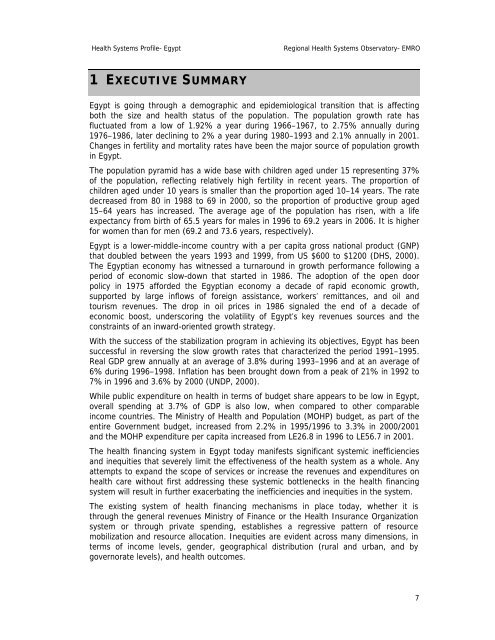Egypt : Complete Profile - What is GIS - World Health Organization
Egypt : Complete Profile - What is GIS - World Health Organization
Egypt : Complete Profile - What is GIS - World Health Organization
You also want an ePaper? Increase the reach of your titles
YUMPU automatically turns print PDFs into web optimized ePapers that Google loves.
<strong>Health</strong> Systems <strong>Profile</strong>- <strong>Egypt</strong> Regional <strong>Health</strong> Systems Observatory- EMRO<br />
1 EXECUTIVE SUMMARY<br />
<strong>Egypt</strong> <strong>is</strong> going through a demographic and epidemiological transition that <strong>is</strong> affecting<br />
both the size and health status of the population. The population growth rate has<br />
fluctuated from a low of 1.92% a year during 1966–1967, to 2.75% annually during<br />
1976–1986, later declining to 2% a year during 1980–1993 and 2.1% annually in 2001.<br />
Changes in fertility and mortality rates have been the major source of population growth<br />
in <strong>Egypt</strong>.<br />
The population pyramid has a wide base with children aged under 15 representing 37%<br />
of the population, reflecting relatively high fertility in recent years. The proportion of<br />
children aged under 10 years <strong>is</strong> smaller than the proportion aged 10–14 years. The rate<br />
decreased from 80 in 1988 to 69 in 2000, so the proportion of productive group aged<br />
15–64 years has increased. The average age of the population has r<strong>is</strong>en, with a life<br />
expectancy from birth of 65.5 years for males in 1996 to 69.2 years in 2006. It <strong>is</strong> higher<br />
for women than for men (69.2 and 73.6 years, respectively).<br />
<strong>Egypt</strong> <strong>is</strong> a lower-middle-income country with a per capita gross national product (GNP)<br />
that doubled between the years 1993 and 1999, from US $600 to $1200 (DHS, 2000).<br />
The <strong>Egypt</strong>ian economy has witnessed a turnaround in growth performance following a<br />
period of economic slow-down that started in 1986. The adoption of the open door<br />
policy in 1975 afforded the <strong>Egypt</strong>ian economy a decade of rapid economic growth,<br />
supported by large inflows of foreign ass<strong>is</strong>tance, workers’ remittances, and oil and<br />
tour<strong>is</strong>m revenues. The drop in oil prices in 1986 signaled the end of a decade of<br />
economic boost, underscoring the volatility of <strong>Egypt</strong>’s key revenues sources and the<br />
constraints of an inward-oriented growth strategy.<br />
With the success of the stabilization program in achieving its objectives, <strong>Egypt</strong> has been<br />
successful in reversing the slow growth rates that characterized the period 1991–1995.<br />
Real GDP grew annually at an average of 3.8% during 1993–1996 and at an average of<br />
6% during 1996–1998. Inflation has been brought down from a peak of 21% in 1992 to<br />
7% in 1996 and 3.6% by 2000 (UNDP, 2000).<br />
While public expenditure on health in terms of budget share appears to be low in <strong>Egypt</strong>,<br />
overall spending at 3.7% of GDP <strong>is</strong> also low, when compared to other comparable<br />
income countries. The Min<strong>is</strong>try of <strong>Health</strong> and Population (MOHP) budget, as part of the<br />
entire Government budget, increased from 2.2% in 1995/1996 to 3.3% in 2000/2001<br />
and the MOHP expenditure per capita increased from LE26.8 in 1996 to LE56.7 in 2001.<br />
The health financing system in <strong>Egypt</strong> today manifests significant systemic inefficiencies<br />
and inequities that severely limit the effectiveness of the health system as a whole. Any<br />
attempts to expand the scope of services or increase the revenues and expenditures on<br />
health care without first addressing these systemic bottlenecks in the health financing<br />
system will result in further exacerbating the inefficiencies and inequities in the system.<br />
The ex<strong>is</strong>ting system of health financing mechan<strong>is</strong>ms in place today, whether it <strong>is</strong><br />
through the general revenues Min<strong>is</strong>try of Finance or the <strong>Health</strong> Insurance <strong>Organization</strong><br />
system or through private spending, establ<strong>is</strong>hes a regressive pattern of resource<br />
mobilization and resource allocation. Inequities are evident across many dimensions, in<br />
terms of income levels, gender, geographical d<strong>is</strong>tribution (rural and urban, and by<br />
governorate levels), and health outcomes.<br />
7

















